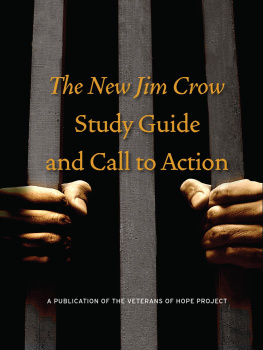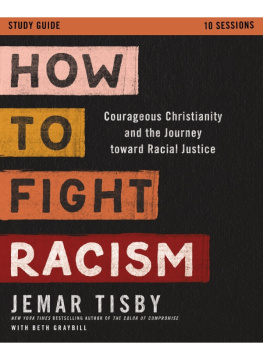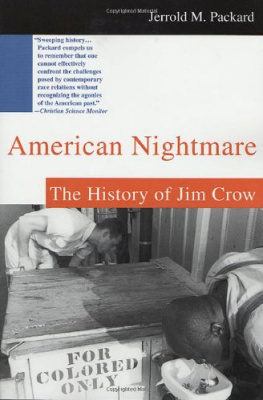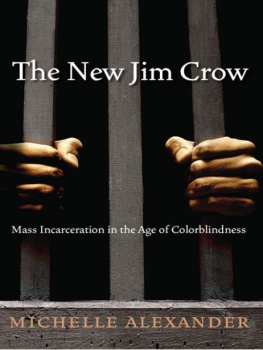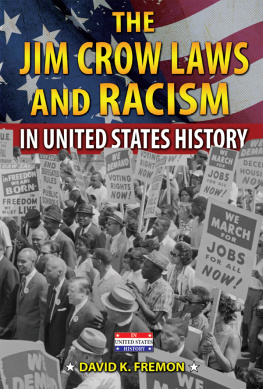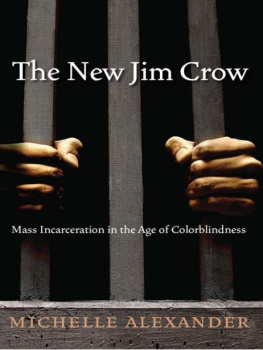The New Jim Crow
Study Guide and
Call to Action

The New Jim Crow Study Guide and Call to Action
2013 by the Veterans of Hope Project. All rights reserved.
The Veterans of Hope Project is a multifaceted educational initiative on religion, culture, and participatory democracy. We encourage a healing-centered approach to community-building that recognizes the interconnectedness of spirit, creativity, and citizenship. Our educational materials are designed to support reconciliation, nonviolence, and an appreciation for the value of indigenous and folk wisdom for contemporary times.
The New Jim Crow Study Guide and Call to Action grew out of conversations among Chris Moore-Backman, Vincent Harding, and Michelle Alexander over the course of 2012. Special thanks to photographers Richard Ross, Lloyd DeGrane, Julia Rendleman, Bob
Fitch, and Jon Lowenstein for permission to use their work.
Page citations for The New Jim Crow correspond with the 2012 paperback edition (also available as an e-book).
Design and composition by Bookbright Media.
Created into e-book by Daniel Hunter, 2015.
Physical copies or ebook of this booklet can be ordered from:
www.NewJimCrowOrganizing.org
On this website you will also find an organizing manual that is designed as a complementary booklet to this resource, especially for groups wanting to move into action.

Photo Bob Fitchwww.bobfitchphoto.com
In honor of Martin Luther King Jr. and the movement that raised him up as spokesperson.
Foreword
Vincent Harding, Chairperson, the Veterans of Hope Project
F or those of us who have begun to discover the extraordinary experience of Michelle Alexanders wise and compassionate work, The New Jim Crow, for those of us who wish to enter more fully into the books amazing richness, this Study Guide and Call to Action is a great gift and a powerful challenge.
It is a gift because it opens the way for usindividually and collectivelyto explore the message of The New Jim Crow even more deeply than we might have been able to without such thoughtful guidance and provocative stimulation. At the same time, this Guide is also an urgent invitation to transformation. For it insists that we take seriously Professor Alexanders demanding call not simply to read and understand her words, but to hear as well the voice of Martin Luther King Jr. and his countless comrades in struggle, calling to his country, their country, our country, America, you must be born again. This Study Guide reminds us that Alexander takes King deeply into her heart, and with him she encourages us to do the demanding work of creating a more perfect uniona country free from the dehumanizing scourge of mass incarceration.
Of course, the Study Guide and Call to Action also challenges us to recognize how much we need each others accompaniment for the work at hand: studying, exploring, imagining together, we will likely discover the wisdom of an African-American elder who recently wrote, The American experiment [with multi-racial democracy] is still in the laboratory. And sister Michellealong with the Guide and the Callreminds us that we create the Beloved Community as we work together on the continuing, daunting task.
In case we have any questions about precisely who is meant to do the work in the laboratory, the late June Jordan, beloved co-worker and poet, would add her loving wisdom to the call of Michelle, the call of King, of Ella Baker, of Fannie Lou Hamer and Anne Braden, the call of all the black and brown young people who are locked away from our sight: We are the ones weve been waiting for. Working with the Guide we hear the call: We are the ones who must not allow anyoneespecially anyone young, filled with color and in need of a new lifeto be locked away from our sight, from our heart.
We are the ones that our children (and arent they all our children?) behind bars, behind fears, behind hopelessness, are waiting for. We are the ones this nation, our nation, is waiting for. Lets continue the great experiment in great hope, moving relentlessly forward toward a more perfect union, sharing our hope with all the imprisoned sons and daughters, sisters and brothers, fathers and mothers, building the Beloved Community as we go. Responding to the call to action that begins deep within us, we discover a new freedom for our children, a new freedom for our nation and for ourselves. We discover Langston Hughess great complaint and great commitment:
O, yes,
I say it plain,
America never was America to me,
And yet I swear this oath
America will be!
This is the gift and the challenge to which the Guide points us. Are we ready to hear the call? Are we ready to hunger and thirst? Are we ready to be filled?
Using This Guide
W e hope that The New Jim Crow Study Guide and Call to Action will be used by a great many groups meeting in a wide variety of settings. The guide has been organized accordingly as a very flexible document, leaving room for each group to discover its own style for engaging with the material. It begins with an introduction followed by four main sections. These sections share a simple three-part format: an opening quotation from The New Jim Crow, a narrative section, and a series of discussion topics and questions.
The guide covers a lot of ground. Depending on your groups interests and circumstances, you may choose to cover all of the material, or you may opt to hone in on particular topics. Whatever the case, as you enter your work together, we encourage you and support you in striving for a group experience that is inclusive, democratic, and emotionally safe for all participants. Toward this end, as your process develops, we think it will be essential to invite and open up the gifts and resources of each person in your group, and to trust that everyone has something of deep value to offer.
In addition to exploring and grappling with the content in the guide, we hope you will protect time and space to reflect together on your groups process. It will be up to you to name what is working and what is not working in your sessions together and to make the needed adjustments. This type of reflection and recalibration takes time. Whats moreas is the case with just about everything folks work on togetherit will undoubtedly call for the 3 Cs that were so characteristic of Martin Luther Kings approach to social change organizing, and to life in general: Courage to see, speak, and hear the truth; Creativity to chart the needed, often unseen course; and Compassion for ourselves and our companions along the way.

Photo Richard Rossjuvenile-in-justice.com
Introduction
I want to discuss the race problem tonight and I want to discuss it very honestly. I still believe that freedom is the bonus you receive for telling the truth. Ye shall know the truth and the truth shall set you free. And I do not see how we will ever solve the turbulent problem of race confronting our nation until there is an honest confrontation with it and a willing search for the truth and a willingness to admit the truth when we discover it.
Martin Luther King Jr., March 14, 1968
N ow and then a book comes along that sounds an alarm, challenging prevailing ways of viewing and interpreting our world and exposing a profound injustice that is hidden in plain sight. The New Jim Crow is such a book. But it is more than that. It is a call to conscience, a call to action. The book argues that nothing short of a major social movementa human rights movement rooted in the recognition of the basic dignity and humanity of all of usholds any hope for ending mass incarceration and breaking the cycle of caste in the United States.
Next page
